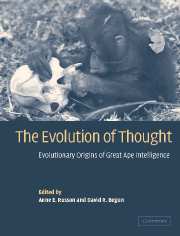Book contents
- Frontmatter
- Contents
- List of Contributors
- Preface
- 1 Evolutionary reconstructions of great ape intelligence
- 2 Enhanced cognitive capacity as a contingent fact of hominid phylogeny
- PART I COGNITION IN LIVING GREAT APES
- PART II MODERN GREAT APE ADAPTATION
- PART III FOSSIL GREAT APE ADAPTATIONS
- Part IV INTEGRATION
- Author index
- Species index
- Subject index
1 - Evolutionary reconstructions of great ape intelligence
Published online by Cambridge University Press: 20 August 2009
- Frontmatter
- Contents
- List of Contributors
- Preface
- 1 Evolutionary reconstructions of great ape intelligence
- 2 Enhanced cognitive capacity as a contingent fact of hominid phylogeny
- PART I COGNITION IN LIVING GREAT APES
- PART II MODERN GREAT APE ADAPTATION
- PART III FOSSIL GREAT APE ADAPTATIONS
- Part IV INTEGRATION
- Author index
- Species index
- Subject index
Summary
INTRODUCTION
Research increasingly shows great apes surpassing other nonhuman primates in their mentality, achieving abilities traditionally considered uniquely human. Importantly, the cognitive capacities that distinguish them include rudimentary symbolic processes, in the sense of processes that operate on the basis of mental images rather than direct sensory-motor phenomena. Although this view does not represent consensus among experts (e.g., Tomasello & Call 1997), many well-respected researchers now accept this interpretation of the empirical evidence (e.g., Byrne 1995; Langer & Killen 1998; Parker & McKinney 1999; Parker, Mitchell & Boccia 1994; Parker, Mitchell & Miles 1999; Russon, Bard & Parker 1996; Savage–Rumbaugh, Shanker & Taylor 1998; Whiten & Byrne 1991; Wrangham et al. 1994).
If great apes are capable of symbolic cognitive processes, views of symbolism as having evolved within the human lineage are incorrect. Implications for understanding cognitive evolution within the primates are complex and important. First, neither the landmark significance of symbolism to cognition nor its importance in understanding the evolution of higher primate cognition is diminished by this revision. What is altered is timing. Symbolic cognition shifts from an achievement of the human lineage to a foundation for it. Second, reconstructions of the conditions leading to the evolution of symbolic processes remain important, but existing reconstructions lose much of their weight because they focus on conditions linked with the divergence of the human lineage. If symbolic processes are the joint province of humans and great apes, ancestral large hominoids are their probable evolutionary source.
- Type
- Chapter
- Information
- The Evolution of ThoughtEvolutionary Origins of Great Ape Intelligence, pp. 1 - 14Publisher: Cambridge University PressPrint publication year: 2004
- 3
- Cited by



